The 11 most common OKR mistakes and how to avoid them

Although OKRs may seem simple at first, implementing them can be tricky. Most companies working with the framework tend to make the same mistakes. In this article, we will summarize the most common mistakes that occur when introducing OKRs and how to avoid them.
💡 Reminder: OKR (short for “Objectives and Key Results”) is an agile framework for formulating and implementing strategic goals in companies that consists of three core elements:
- Objectives: What do I want to achieve?
- Key Results: How do I know that the goal has been achieved?
- Initiatives: How do I achieve the Objective?
As a rule, 2 to 4 Objectives are formulated per team and 2 to 4 result-oriented Key Results per Objective. The output is mapped in initiatives (= concrete activities). More basic knowledge can be found in our OKR guide.
These are the eleven most common mistakes in dealing with OKRs:
- Only using a top-down approach for setting OKRs
- Confusing OKRs with KPIs
- Setting too many OKRs per cycle
- Using OKRs for everything
- Formulating Key Results as a to-do list
- Failing to create alignment between teams
- Not adapting the framework to the company's needs
- Not using OKR software
- Using OKRs for performance reviews
- Not continuously reviewing progress
- Working with individual OKRs
1. Only using top-down OKR approaches
One of the biggest mistakes in OKR implementations is setting OKRs at the management level and cascading them from top to bottom. This can lead to employees feeling disconnected from the OKRs, since they may not feel sufficiently involved. In turn, they might feel less motivated to implement the OKRs. Additionally, leaders are often not as close to the action, so they may have difficulty assessing which initiatives will ultimately have the greatest impact.
✅ Doing it right:
OKRs should be planned top-down and bottom-up. In the first step, management should set strategic company-wide OKRs based on the company's vision and mission. Then, individual teams should derive their own OKRs and align them with at least one of the company OKRs. They should then collaborate to work out the OKRs together in the OKR planning session. This breaks away from the traditional waterfall model: all team members come prepared to the OKR planning meeting, bring ideas for Objectives and Key Results, and participate in the discussion.
Overall, this makes teams more self-organized and improves both vertical (between levels) and horizontal (between teams) alignment. Plus, during the planning process, teams see how their OKRs contribute to the company's goals, which helps them identify better with the OKRs and be more motivated to implement them.
Throughout all of this, even if the OKRs are developed collaboratively, leaders should always lead by example. Only then will the agile mindset and way of working be embraced by everyone.
2. Confusing OKRs with KPIs
OKRs are often confused with Key Performance Indicators (KPIs), even though they are different concepts. OKRs aim for change, while KPIs measure the status quo and the company's past performance. Confusing OKRs with KPIs might result in the inspirational character of OKRs being lost and consequently lead to a lack of change.
✅ Doing it right:
OKRs and KPIs can be effectively combined when the role and purpose of both concepts are clearly distinguished. KPIs help monitor the status quo and identify problems and improvement potentials. OKRs ensure that these problems are solved, processes are improved, and innovations are advanced. Basically, KPIs make visible where changes are necessary through ORKs – the two concepts complement each other. Key Results can also contain KPIs, but do not have to.
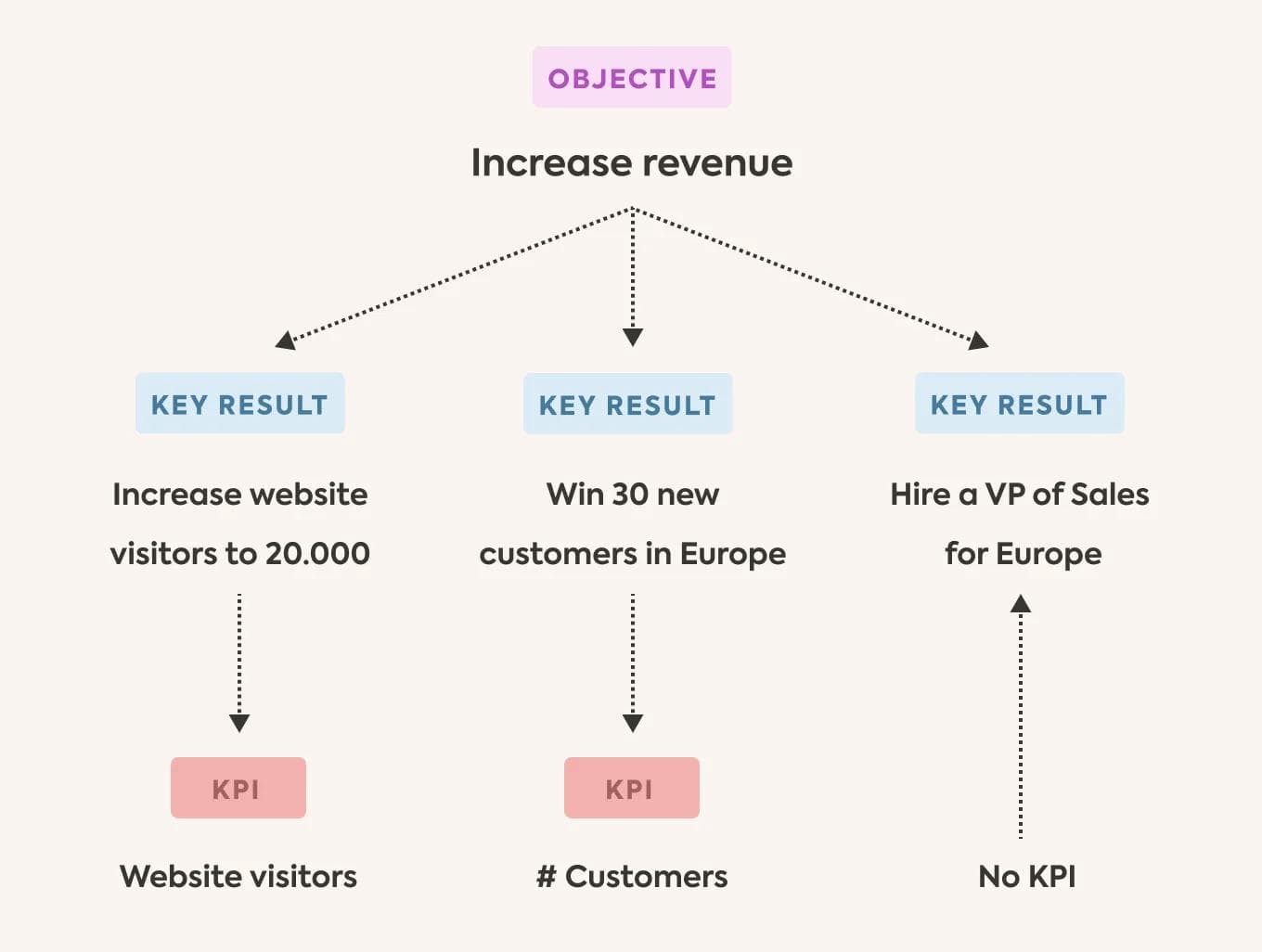
3. Setting too many OKRs per cycle
Many companies want to achieve as many goals as possible as quickly as possible. Based on this thinking, they set too many OKRs per cycle only to realize that they cannot manage the implementation in terms of time and resources. The workload becomes too high, and the focus on important goals is lost. Ultimately, this leads to little or no results.
✅Doing it right:
The focus should be on a few significant OKRs. For each OKR cycle, there should not be more than two to four Objectives per team and two to four result-oriented Key Results per Objective. Doing so sets clear focus areas for a cycle. Employees know exactly where priorities lie and can allocate their resources accordingly.
4. Using OKRs for everything
Although the framework is quite simple, the purpose of OKRs is often misunderstood. Companies tend to try to map everything they do into OKRs. As a result, OKRs end up lacking ambition and only map day-to-day operations. Thus, they do not deliver any real added value. If anything, they create confusion and duplicate effort instead of making a real difference.
✅ Doing it right:
OKRs should always be growth-oriented. They are used to improve or innovate something within a team or a company. OKRs are therefore well suited to managing change processes. The main question when creating OKRs should always be: What do we need to change to implement our strategy in this cycle? OKRs should then be developed for these points. This does not necessarily involve all areas in the company. Employees in sales, for example, often already have clear weekly and monthly numbers they are working toward. If these fit the strategy, no additional OKRs are necessary.
5. Formulating Key Results as a to-do list
Key Results are often misunderstood and formulated as a list of tasks. Creating a checklist of activities instead of real Key Results prompts an output-focused work approach rather than an outcome-focused one and is not results-oriented. This leads to the wrong measurement of OKR progress and bogus OKRs being set. In other words, incorrectly formulated Key Results show that something has been done but not whether it has brought any real (business) value. However, Key Results are meant to measure precisely that value.
The motivation of employees also runs at risk if Key Results are formulated incorrectly. After all, only working on tasks without meaningful goals can lead to demotivation in the long run, resulting in valuable potential remaining untapped, and the OKRs missing their intended purpose.
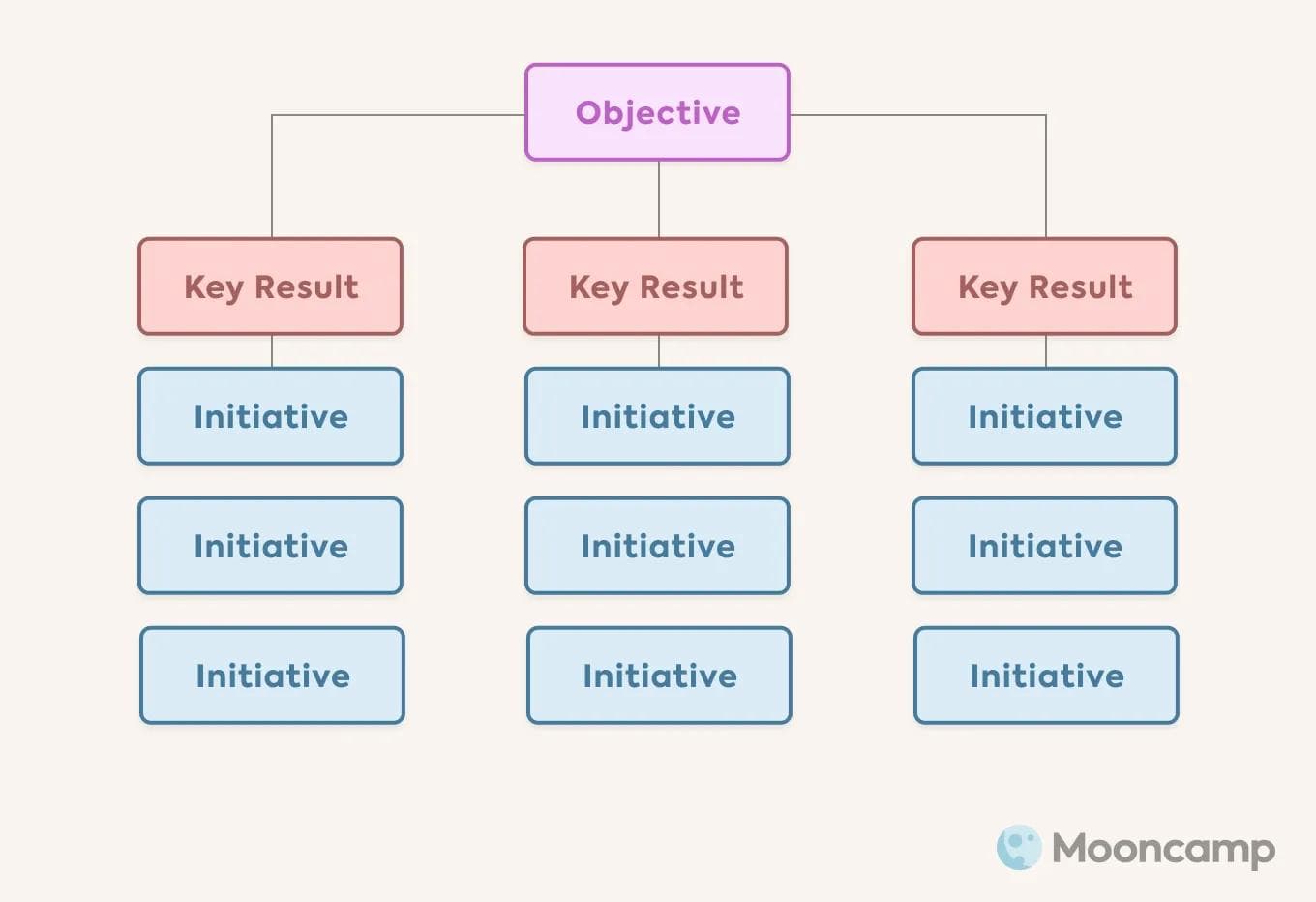
✅ Doing it right:
To succeed with OKRs, Key Results should always be formulated with a focus on outcome. Only then do they truly capture whether progress toward the Objective is being made. Moreover, they must directly relate to the Objective and be measurable. This means that each Key Result should always be accompanied by one specific metric and its target value.
The specific to-dos and activities are then derived from the Key Results and expressed through initiatives. The initiatives are formulated in a way that drives the work results and positively influences the Key Results.
💡 Tip: You can find all the criteria for good Key Results (and Objectives) as well as specific formulation guidelines in our article "How to write OKRs: A guide for effective Objectives and Key Results [+ Examples]". It's also worth taking a closer look at the difference between Output vs. Outcome.
6. Failing to create alignment between teams
For OKRs to work, the entire organization must be aligned. In practice, however, teams tend to pursue their goals without considering the overarching company Objectives or the goals of other teams. Silos are formed, different work directions ensue, and cross-team collaboration becomes challenging.
✅Doing it right:
Alignment between all teams and employees does not happen automatically. An OKR workshop can pave the way for seamless collaboration. On that note: Team OKRs should always be aligned with the overarching company Objectives first, ideally in the OKR planning session itself. Additionally, in separate OKR alignment workshops, it should be worked out which other teams the team relies on – and how they can work together to achieve the OKRs most effectively. Only then can the benefits of OKRs be fully realized.
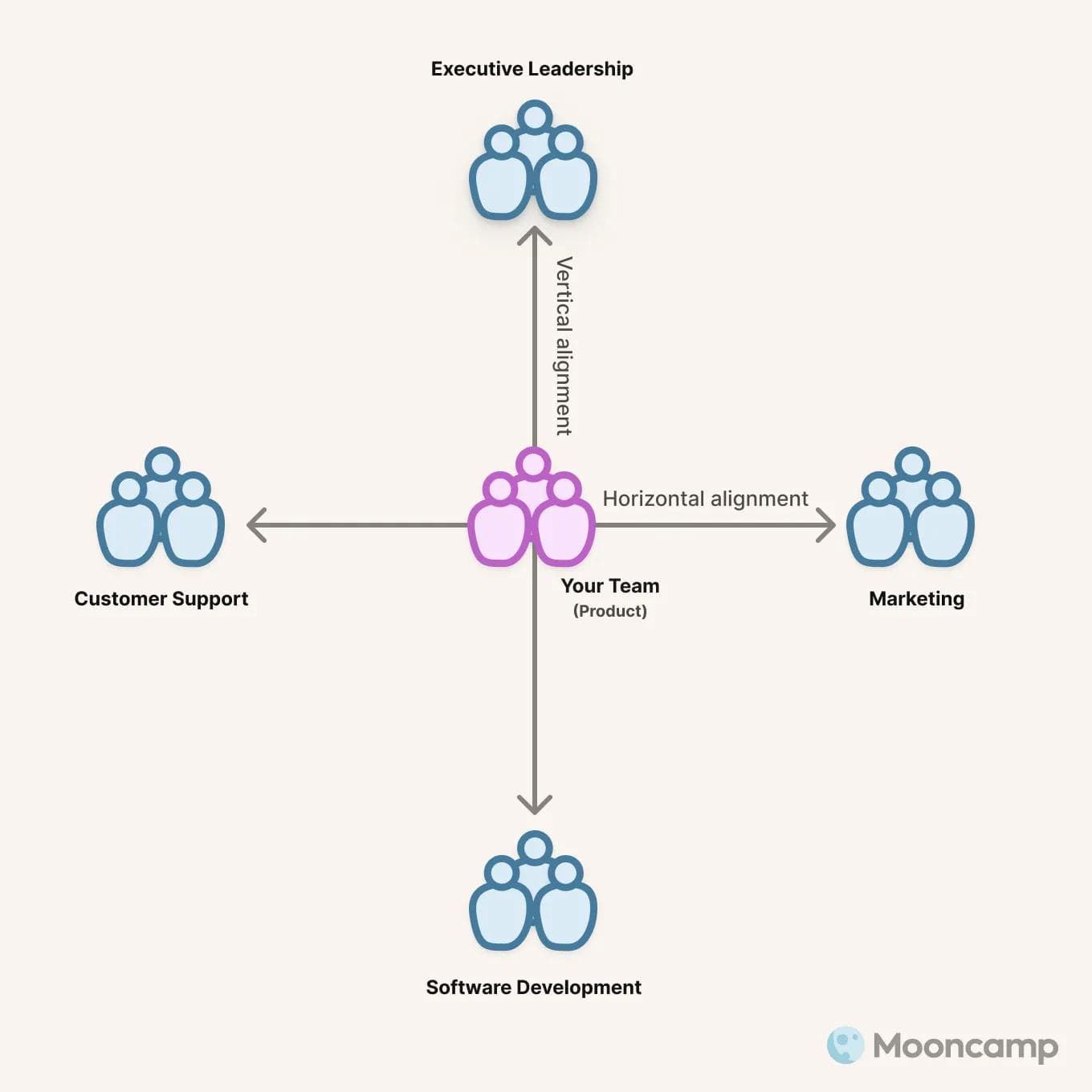
7. Not adapting the framework to your own company
Companies that try to implement OKRs usually first read some OKR books and blog articles, look at examples from other companies, and then try to copy what they've read.
The problem: Every company is unique, with its own goals, work methods, structures, and values. Companies that try to mimic the OKR method of others are likely to fail. This is because the flexible framework becomes a rigid model that doesn't align with the company's objectives and doesn't resonate with the team members. As a result, the intended benefits are not realized, and the 'OKR experiment' is deemed a failure after just one cycle.
✅ Doing it right:
Books, blogs, etc. are a good start and help you become familiar with the framework, including terminology. Best practices from other companies, Dos and Don'ts, or OKR examples are also useful input. However, the knowledge acquired shouldn't be taken at face value as OKRs are meant to be adapted to your company’s individual situation.
One should look closely at:
- how the company works,
- what vision and mission are being pursued,
- what the company culture looks like,
- what vocabulary is used within the company,
- what the current structures and processes look like, and
- what problems one wants to solve with OKRs.
One should also gather suggestions and opinions from employees as it is best to work alongside them when developing the OKR process. Participating in training sessions and workshops also helps understand the subject and the method better and to adapt it to individual needs.
With this in mind, you should always adapt the OKR process so that it best suits your own company. This does not mean blindly following existing structures. Rather, it is about using the OKRs to evolve and gradually create a new, improved standard.
💡 Reminder: OKRs provide a framework, not a fixed set of rules. It can take time to adapt all aspects of working with OKRs to the individual organizational context. It is normal for cycles to be somewhat chaotic at first. One should stick with it, reflect on mistakes in the OKR retrospective and use them as an opportunity to learn.
8. Not using OKR software
During the first few attempts at OKRs, common tools such as Google Sheets or Excel are usually enough to manage the goals and the process. But as you try to scale OKRs in the company, just using these tools is not sufficient. This can make it hard to see how things are going. The whole OKR process can get confusing, and tasks like OKR reporting and working with other teams can take a lot of time.
✅Doing it right:
A dedicated OKR software supports you through all the steps in the OKR process. It also helps keep an overview when working with many OKRs, even in large companies. This makes it easier to integrate new processes and structures into everyday work. Keep in mind that OKR software is not intended to replace human interaction. Instead, it supports the process and makes it scalable. The software visualizes goals and structures, centralizes communication and facilitates the evaluation of OKRs. Having a tool through which all OKRs in the company are created, updated, and tracked also promotes transparency since employees can see who is responsible for what and how their work contributes to the company's goals.
💡 Tip: The larger a company is, the more important and useful OKR software becomes. As a rule of thumb, OKR software can be helpful for smaller companies with up to 100 employees, but often good OKR templates are enough. But beyond 100 employees, having an OKR software becomes important as it unfolds its full potential. Starting at 1,000 employees it is even indispensable.
Just like the framework, the software should adapt to the company – not the other way around. With Mooncamp, for example, the complete OKR system can be individualized according to the needs and processes of an organization.
Among other things, Mooncamp can be used to…
- plan OKRs in a structured way
- define individual cycle lengths, OKR rules, and formulations
- visualize OKRs clearly
- track OKR progress and analyze it via an OKR dashboard
- set up recurring reminders for important events and tasks within the OKR cycle
- link tools already in use (such as Slack, MS Teams or Asana) to integrate the OKRs even better into the daily work routine
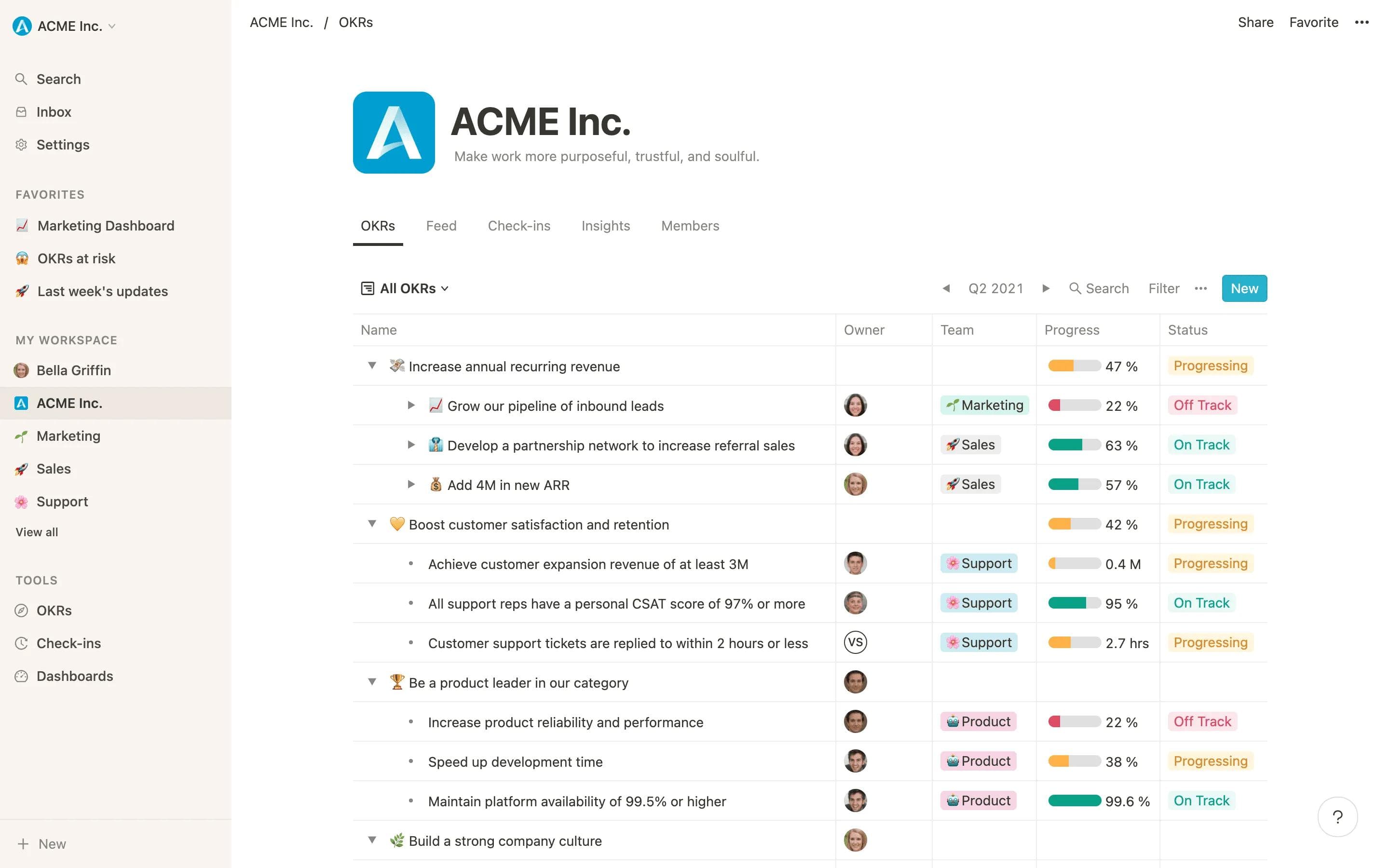
9. Using OKRs for performance evaluations
Oftentimes OKRs are used as a performance appraisal tool. While this seems sensible on the surface, it is problematic for several reasons:
- What constitutes good performance is difficult to quantify.
- Many OKR-worthy projects have ambiguous goals.
- Evaluation is usually subjective.
- Change processes are very sensitive to external influences.
In addition, if OKRs are linked to employee compensation, this quickly tempts "sandbagging”. Meaning that targets are deliberately set so low that they are certain to be achieved. In this way, the positive effect of OKRs is lost.
✅ Doing it right:
OKRs only develop their full power if they are set ambitiously. They should stimulate innovation and encourage experimentation. But linking OKRs and classic performance management is counterproductive to this intention and inhibits the team. OKRs and compensation should therefore always remain separate. Mixing personal development goals and OKRs should also be avoided for the same reasons.
Bear in mind that modern Continuous Performance Management (CPM), which is based, among other things, on ongoing appreciation, constructive feedback, and frequent check-ins and conversations, can actually fit well into the OKR process. Here, the OKRs represent the company and team levels, while CPM is responsible for individual development. The achievement and development of OKRs can then be addressed in individual discussions with the respective employees. However, it should always be clear that they are not tied to performance appraisals or financial rewards.
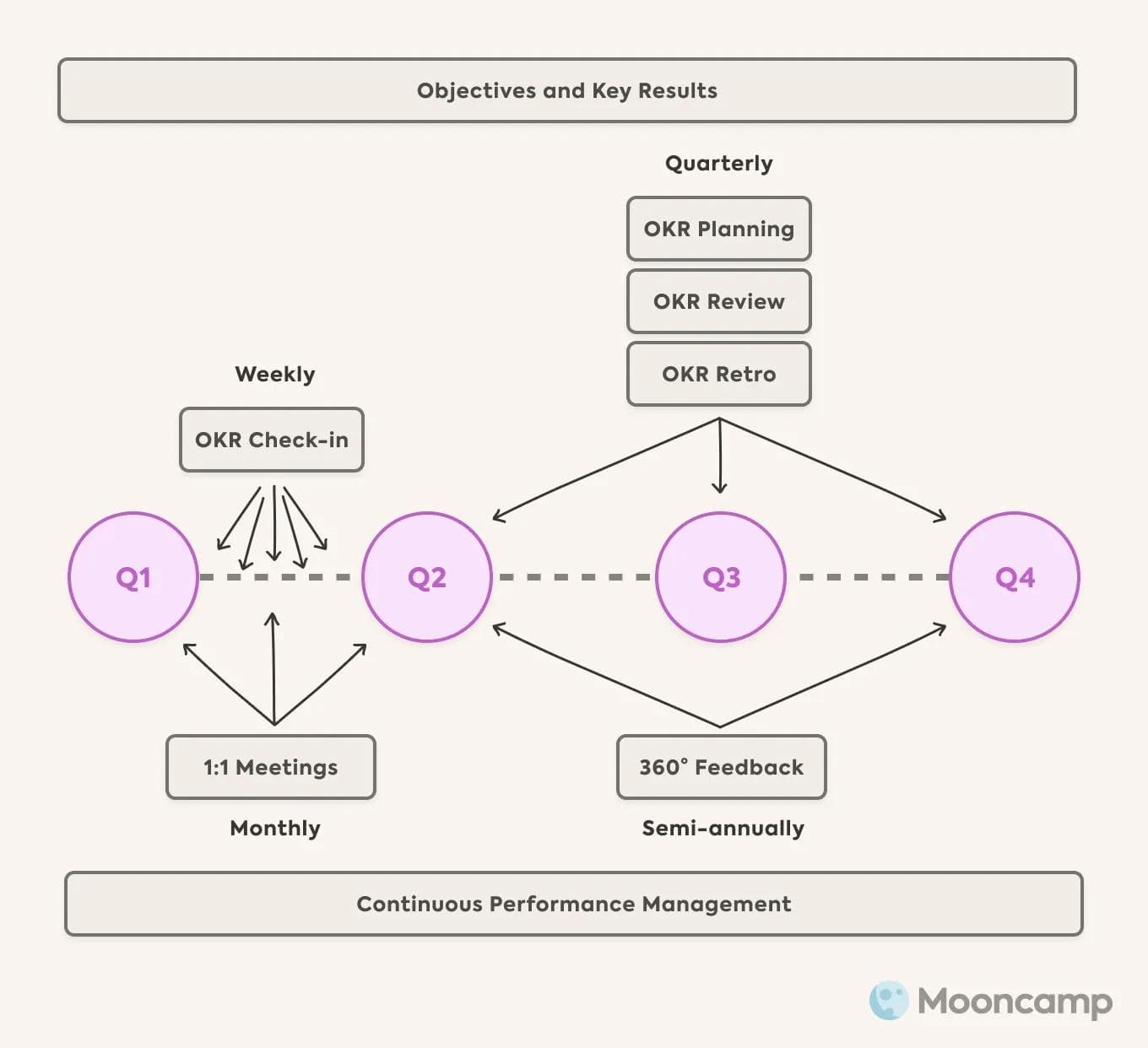
💡 Tip: For more information on how OKRs and continuous performance management can align and reinforce each other, check out our blog.
10. Not continuously reviewing progress
Even when OKRs are properly planned and formulated, it is common for them to disappear into an Excel spreadsheet after the OKR planning and never be looked at again until the end of the cycle. Check-ins are the most overlooked, but probably the most important element if you want to succeed with OKRs. Failing to do them can result in problems and discrepancies going undetected. If they are then discovered, it is usually too late to readjust the course of action. Employees also tend to feel less accountable and less motivated to work on their OKRs if they are not continuously present.
✅ Doing it right:
OKRs should become an integral part of daily business. Regular OKR check-ins (weekly or every two weeks) ensure that everyone in the team is working together and taking responsibility. They create commitment in everyday work and ensure that work on the OKRs is continuous. In addition, successes, challenges, and progress are shared transparently within the team. This improves communication, motivates, and makes problems and obstacles visible at an early stage. This allows solutions to be found more quickly and, if necessary, the OKRs to be adapted to the new circumstances.
Overall, this creates an agile environment in which companies can react flexibly to changes and new situations – while at the same time ensuring that they continue to successfully pursue their goals.
💡 Tip: In a separate article we summarized exactly how an OKR check-in works and what tricks can be used to make weekly meetings even more productive.
11. Working with individual OKRs
OKRs can in principle be applied at all levels – from corporate OKRs to OKRs for individual teams and/or products all the way to individual OKRs. If OKRs are practiced on all levels right at the start, it is likely that they will fail. The reason: employees are overwhelmed because they need to contribute to
- the company OKRs,
- their manager's OKRs,
- (cross-departmental) team and/or product OKRs,
- AND their own individual OKRs.
What's more, not all people can work well with individual OKRs. Employees are then slowed down rather than motivated by the personal OKRs.
✅ Doing it right:
Less is more. Companies should focus on the most important issues. A handful of well-chosen OKRs, for example, is enough to align all employees around common outcomes. At the same time, employees should have the freedom to decide for themselves how exactly they will work toward the goals. Individual OKRs that prescribe every step are not necessary. By defining for themselves how they can contribute to corporate and/or team OKRs, employees are more likely to unleash their potential and achieve better results. Whether everyone is on track is checked during the weekly check-ins and if necessary, improvements are then made together.
The most common OKR mistakes: FAQ
How do you formulate OKRs?
OKRs should be formulated in a transparent and understandable way. Objectives should be effective, targeted, and qualitative. They should be formulated as actively as possible. Two to four Key Results are formulated for each Objective. These must be measurable, specific, and time-bound and relate directly to the respective objective.
Why do OKRs fail?
OKRs can fail for a variety of reasons. Some typical OKR stumbling blocks are lack of (time) resources, complicated or unclear wording, too many Objectives, lack of transparency and measurability, or lack of alignment.
Why are OKRs important?
OKRs help teams and organizations focus on the most important goals and work together toward them. They align everyone around a vision and mission. At the same time, they promote results-oriented work, enable flexibility and provide transparency. Used correctly, they make companies more successful in the long run.

